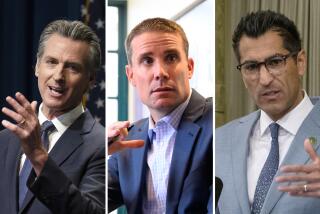California’s soaring healthcare costs bode ill for the budget
- Share via
Reporting from SACRAMENTO — California’s budget, which bounced back after years of deficits, is now being squeezed by rising healthcare costs for the poor and for retired state workers.
The mountain of medical bills threatens to undermine Gov. Jerry Brown’s efforts to strengthen state finances — his central promise of the past four years.
Enrollment in the state’s healthcare program for the poor, known as Medi-Cal, has exploded by 50% since President Obama’s signature law took effect. Although the federal government picks up most of the tab, state costs have also been growing, and faster than expected.
Meanwhile, the annual bill for healthcare for public retirees — a benefit promised decades ago — has more than doubled in the last decade. Current and retired workers have accumulated $71.8 billion in healthcare benefits as of June last year, and the state has set aside almost nothing to cover the costs.
Brown faces both challenges and more as he prepares to release his new budget proposal Friday.
University of California officials say more funding is necessary to avoid a tuition increase that the governor opposes. State roads need tens of billions of dollars in overdue maintenance. And some of Brown’s fellow Democrats are already pushing for more services for the poor.
The governor, however, has repeatedly pledged to keep a tight leash on spending. In his inaugural address Monday, he said the budget is balanced “more precariously than I would like.”
California has reaped $1.2 billion more revenue than expected in the first five months of the current fiscal year, according to the latest administration statistics. But higher healthcare costs could chew up much of the extra money.
“Providing the security of health coverage to so many Californians who need it is the right thing to do,” Brown said Monday. “But it isn’t free.”
Over the next year, total Medi-Cal enrollment is expected to reach 12.2 million, he said — about one-third of the state’s population. It was less than 8 million in 2013.
Even though costs are increasing, advocates for the poor say the state has not allocated enough money to provide healthcare to those who are still struggling years after the recession. Payments for Medi-Cal services were reduced during years of budget crises, making doctors more reluctant to participate in the program.
Restoring that money, which was $300 million last year, would help ensure that poor Californians receive the healthcare they have been promised, said Assembly Speaker Toni Atkins (D-San Diego).
“The program is only going to be successful if we’re able to have the providers who will provide the service for all the people that are enrolling in Medi-Cal,” she said. “We’ve got to cover the cost of providing the service.”
Obama’s new immigration policy could also increase healthcare costs. More than a million California immigrants who are in the country illegally are expected to be protected from deportation, and many will probably qualify for Medi-Cal, but those costs cannot yet be calculated, according to the Brown administration.
Senate leader Kevin de León (D-Los Angeles) said he’s interested in extending healthcare coverage to even more immigrants who are in the country illegally, as long as the money can be found.
There are also long-term healthcare costs for retired public workers. Most earn healthcare for life after 10 years on the job, with the state picking up the full tab for many after 20 years. Employees of the Legislature, the courts system and California State University reach full benefits after five years.
“The whole time they’ve been making these retiree healthcare promises, they should have been pre-funding them,” said David Crane, a Stanford University lecturer who advised former Gov. Arnold Schwarzenegger on financial issues.
In the 2005-06 fiscal year, retiree healthcare cost $887 million. In the current fiscal year, it’s $1.8 billion.
Although Brown and lawmakers have begun chipping away at pension funding problems, they have not addressed the healthcare issue. In his inaugural speech, the governor said he would ask state employees to start paying more for the benefit, but he did not provide details.
Dave Low, chairman of Californians for Retirement Security, a union-backed organization, supports setting aside more money for healthcare benefits as long as the state also chips in and the amounts are determined through collective bargaining.
Three unions have already agreed to devote more money to health benefits, although a relatively small sum, $41.33 million, has accumulated so far.
Low said that the funding issue is overblown and that the annual cost isn’t large when compared with the rest of the state budget.
“It’s not a big deal,” he said. “They could go on, just the way it is, for quite a while.”
Assembly Republican leader Kristin Olsen of Modesto disagreed, pointing to the spiraling costs.
“Moving forward, we have to make changes to the program so it can survive,” she said.
Some money could be saved by shifting state workers into the insurance exchanges set up by Obama’s healthcare law. If retirees qualify for federal subsidies, the state could spend less to provide the benefit.
In addition, the rainy-day fund plan approved by voters in November requires that money be sequestered to help the state deal with long-term costs. It has been suggested that some of the cash help pay for retiree healthcare.
Twitter: @chrismegerian
Times staff writers Melanie Mason and Patrick McGreevy contributed to this report.
More to Read
Sign up for Essential California
The most important California stories and recommendations in your inbox every morning.
You may occasionally receive promotional content from the Los Angeles Times.














